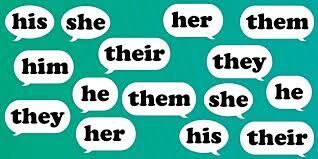What’s In A Pronoun?

What’s In A Pronoun?
September 1, 2021
*Important Disclaimer: This piece serves as an introduction to the concept of respecting pronouns to those mildly or not at all familiar with this concept, especially when it comes to terms outside of the gender binary. It will not cover every single aspect of existing as a queer person at Villanova University or in the world. This writer identifies as queer, has navigated some of these experiences and acknowledges the white privilege associated with being white and queer in the sphere of education and beyond. Furthermore, this piece uses “they/them” to refer to nonbinary people. This writer understands not all nonbinary people want to be referred to as “they/them.” These terms were used in an in order to encompass all nonbinary identities in holistic statements.*
The start of classes, also known as Sylly Week, has brought on an onslaught of ice-breakers, get-to-know-you presentations and introductory name tags on every table. Among the many questions asked of all students, apart from their names and their hometowns, the question of students’ pronouns has become increasingly popular in classrooms all across the country.
Pronouns, as anyone who has been taught grammar will tell you, are classified as terms used to refer to a person, usually when they are not present. The particular term employed to refer to a person is often determined by one’s preference and gender identity. More and more people are choosing to request pronouns existing outside of the traditional gender binary. Historically, “female” and “male” have been the only two identities accepted and widely acknowledged, particularly in Western culture. As for some other cultures throughout the world, multiple gender identities exist outside of the binary with high respect and regard within their communities. While the concept of the gender binary being a flexible and widely varied construct has existed for a long time, the dissection of its construction in Western culture has only become a more widely discussed and respected topic in recent years.
There has been an increase in the amount of research and discourse in the current literature about what gender identity means today and how it exists within a society that is unlearning the enforcement of strict gender roles, or traits and judgements developed based on how feminine or masculine one may be perceived by the public. This increase of knowledge has also caused a shift in attitude towards people identifying outside of the binary, including within the Villanova community.
When asked what they thought about the emphasis on knowing pronouns in the classroom, an anonymous sophomore English and Psychology double major provided insight.
“It isn’t right to assume what someone’s gender identity is simply based off of what they look or sound like, so asking for pronouns gives the clarification and makes the environment more safe and accepting for everyone,” the student said.
Another anonymous sophomore Finance major shared thoughts about the subject.
“It’s important to correctly refer to people when talking to them or about them,” the student said.
Ultimately, it is agreed that the point of acknowledging one’s preferences is a matter of basic respect and makes learning spaces safer for students to express and participate as their truest selves. When students are welcomed as they wish to be, they are more inclined to be open in class discussions and raise their hand more often. The comfort and acceptance gives students room to grow in and out of the classroom.
While we have been making strides in pronoun preferences on campus, there are still more steps to take.
An anonymous sophomore Biology major noted she was only asked her pronouns in some of her classes.
Navigating through the concept of gender identity can feel foreign and confusing for those more comfortable with the construct of the binary. However, it is important to remember that the practice of asking pronouns makes every classroom more cohesive to inclusivity.
To foster that sort of environment, remember to ask for student pronouns and use the proper terms. If someone expresses the desire to be called by more than one (Examples include: “I use she/they pronouns” / “I use any pronouns” / I go by they/he”), make sure to use any and all pronouns interchangeably. If a student or peer expresses an interest in using new pronouns in class, congratulate them on exploring and investigating who they are, but do not pry into their process or progress. If someone says they prefer a certain pronoun, use it properly. These questions go a long way as we try to answer the questions we all ask ourselves every day as Villanovans and as the scholars of the Augustinians: “Who am I?” And celebrating each other’s progress on our paths to answering that question is always a cause for celebration.

